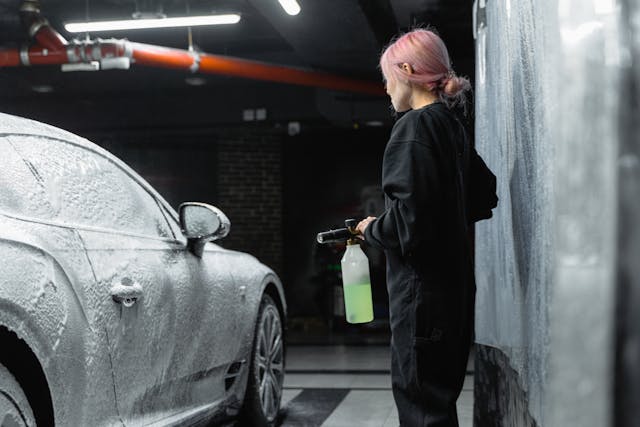Your automobile is an important investment that has to be taken care of and maintained if you want it to serve you well for many years to come. It’s more than simply a means of transportation. There are two basic methods for maintaining your car: reactive repairs and preventive maintenance. While every technique has advantages and disadvantages of its own, developing a sustainable strategy to automobile maintenance necessitates realizing the value of proactive rather than reactive care.
Maintenance in Advance:

The goal of preventative maintenance is to proactively address any problems before they become more serious. This method focuses on doing routine maintenance, replacing worn-out components, and inspections in accordance with the manufacturer’s suggested timetable. Car owners may prolong the life of their cars, increase dependability, and lower the chance of unplanned failures by keeping up with maintenance activities.
Preventative maintenance must include routine filter replacements, tire rotations, fluid checks, oil changes, and brake inspections. These regular maintenance procedures not only improve your car’s performance but also, over time, reduce total running expenses and improve fuel economy. Additionally, by maintaining your car in excellent condition, preventive maintenance may help maintain its market value.
Reactive Maintenance:
Conversely, reactive repairs deal with problems as they come up. This method is often utilized when an issue has already resulted in a malfunction or breakdown, necessitating emergency repairs. Reactive repairs are sometimes necessary, however depending only on this strategy might result in greater expenses, longer downtime, and even possible safety hazards.
If you wait until a part breaks before fixing it, other sections of the car may suffer more severe damage, necessitating more costly repairs later on. Furthermore, reactive repairs often happen without warning, interfering with your regular schedule and trapping you until the problem is fixed. Ignoring preventive maintenance may sometimes even result in the voiding of warranty coverage, leaving you fully liable for repair costs.

Constructing a Sustainable Method:
It is crucial to give priority to preventive maintenance over reactive repairs wherever feasible in order to create a sustainable strategy to automobile care. This entails continuing to service your car in accordance with the manufacturer’s instructions and taking care of any problems before they become bigger ones.
Frequent inspections by skilled professionals may aid in the early detection of small problems, enabling prompt intervention and reasonably priced repairs. The long-term dependability and performance of your car may also be enhanced by spending money on high-quality components and maintenance from respectable auto shops.
Even though reactive repairs can still be required sometimes, particularly in an emergency, reducing their frequency with preventive maintenance will ultimately save you time, money, and frustration. You may have confidence that your automobile is dependable, well-maintained, and prepared for the road ahead by taking a sustainable approach to car maintenance.
Developing a Sustainable Approach to Auto Care: Preventative Maintenance vs. Reactive Repairs
Your automobile is an important investment that has to be taken care of and maintained if you want it to serve you well for many years to come. It’s more than simply a means of transportation. There are two basic methods for maintaining your car: reactive repairs and preventive maintenance. While every technique has advantages and disadvantages of its own, developing a sustainable strategy to automobile maintenance necessitates realizing the value of proactive rather than reactive care.
Maintenance in Advance:
The goal of preventative maintenance is to proactively address any problems before they become more serious. This method focuses on doing routine maintenance, replacing worn-out components, and inspections in accordance with the manufacturer’s suggested timetable. Car owners may prolong the life of their cars, increase dependability, and lower the chance of unplanned failures by keeping up with maintenance activities.
Preventative maintenance must include routine filter replacements, tire rotations, fluid checks, oil changes, and brake inspections. These regular maintenance procedures not only improve your car’s performance but also, over time, reduce total running expenses and improve fuel economy. Additionally, by maintaining your car in excellent condition, preventive maintenance may help maintain its market value.

Reactive Maintenance:
Conversely, reactive repairs deal with problems as they come up. This method is often utilized when an issue has already resulted in a malfunction or breakdown, necessitating emergency repairs. Reactive repairs are sometimes necessary, however depending only on this strategy might result in greater expenses, longer downtime, and even possible safety hazards.
If you wait until a part breaks before fixing it, other sections of the car may suffer more severe damage, necessitating more costly repairs later on. Furthermore, reactive repairs often happen without warning, interfering with your regular schedule and trapping you until the problem is fixed. Ignoring preventive maintenance may sometimes even result in the voiding of warranty coverage, leaving you fully liable for repair costs.
Constructing a Sustainable Method:
It is crucial to give priority to preventive maintenance over reactive repairs wherever feasible in order to create a sustainable strategy to automobile care. This entails continuing to service your car in accordance with the manufacturer’s instructions and taking care of any problems before they become bigger ones.
Frequent inspections by skilled professionals may aid in the early detection of small problems, enabling prompt intervention and reasonably priced repairs. The long-term dependability and performance of your car may also be enhanced by spending money on high-quality components and maintenance from respectable auto shops.
Even though reactive repairs can still be required sometimes, particularly in an emergency, reducing their frequency with preventive maintenance will ultimately save you time, money, and frustration. You may have confidence that your automobile is dependable, well-maintained, and prepared for the road ahead by taking a sustainable approach to car maintenance.
In summary:
Setting proactive care as the top priority in the continuing dispute between reactive repairs and preventive maintenance is crucial to developing a long-term strategy for automobile care. Car owners may improve their peace of mind while driving, prolong the life of their cars, and save repair expenses by keeping ahead of maintenance activities and resolving any problems early on. Recall that investing in preventative maintenance today may help you preserve the investment’s lifetime and worth later on. Thus, take control of your car’s upkeep now and profit from a well-maintained vehicle later on.
Frequently Asked Questions About Auto Repair:
1. Why is it crucial for my automobile to get preventive maintenance?
The goal of preventative maintenance is to find any problems early on and fix them before they become serious ones. Frequent maintenance and examinations may increase the longevity, dependability, and probability of unplanned malfunctions in your car.
2. How often should my automobile be serviced?
The age, make, and model of your automobile, as well as your driving style, all affect how often you should get it serviced. To find out the manufacturer’s suggested maintenance plan, which usually includes things like tire rotations, oil changes, and fluid checks, consult your owner’s handbook.
3. What are the advantages of doing repairs using original OEM parts?
Original equipment manufacturer (OEM) components are made especially for your car and guarantee optimum compatibility and performance. Even while aftermarket components might be less expensive, their quality and dependability may be compromised, which could result in future repairs that are more expensive.
4. How can I determine if my automobile need emergency care?
Watch for indicators of impending danger, such as odd sounds, dashboard warning lights, fluid leaks, or adjustments in performance. It’s critical to take quick action to fix any of these problems if you find them in order to stop more harm and guarantee your safety while driving.
5. Which routine preventive maintenance chores should I give top priority?
Preventative maintenance chores like routine tire rotations, fluid checks, filter replacements, and brake inspections are crucial. Long-term dependability and performance of your automobile may also be enhanced by maintaining proper cleanliness, keeping an eye on the condition of your tires, and driving defensively.
6. How can I locate a trustworthy vehicle repair and maintenance facility?
Seek for vehicle repair companies that provide upfront pricing and guarantees on their services, have a solid reputation in the neighborhood, and employ qualified technicians. To locate a reliable service provider, ask friends, relatives, or read internet reviews for suggestions.
7. Is the expense of preventive maintenance justified?
Preventative maintenance may save you money over time by prolonging the life of your car and avoiding expensive repairs, even if it may involve an initial expenditure. Frequent maintenance also guarantees a safe and pleasurable driving experience and preserves the value of your automobile when you sell it.
8. Should I hire specialists to do preventive maintenance work, or can I do it myself?
With the correct equipment and know-how, automobile owners can do certain simple maintenance duties like changing air filters or monitoring fluid levels. To guarantee accuracy and safety, it is advisable to leave more complicated treatments to skilled specialists, such as engine diagnostics or brake repairs.
9. In the event that I have an issue while driving, what should I do?
If you have a breakdown or mechanical problem while operating a motor vehicle, pull over to the side of the road safely and activate your warning lights. Examine the circumstances and, if required, dial for a tow truck or roadside help. Do not try repairs on your own unless you have the required knowledge and equipment.
10. How can I set up an auto maintenance schedule?
The manufacturer’s suggested maintenance plan, which usually describes particular activities and intervals depending on mileage or time, may be found in your owner’s handbook. To be proactive about taking care of your automobile, keep note of its service history and schedule recurring maintenance.